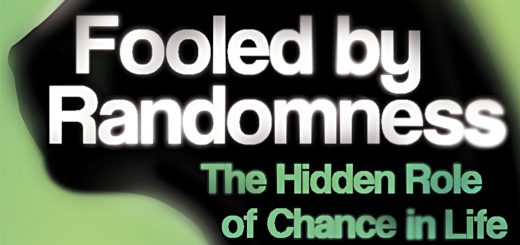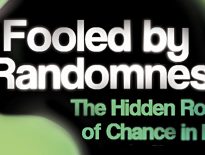Fooled By Randomness 4 – Induction and Survivorship

Today’s post is our fourth visit to Nassim Nicolas Taleb’s modern classic Fooled By Randomness.
Contents
Induction
In Chapter Seven we come to the problem of induction, as stated by Hume and John Stuart Mill in the black swan problem:
No amount of observations of white swans can allow the inference that all swans are white, but the observation of a single black swan is sufficient to refute that conclusion.
The underlying idea is that we need to be careful in our observations when gathering and interpreting knowledge.
- This process is known as epistemology.
Taleb refers us to Niederhoffer’s dogma that any “testable” statement should be tested, since we humans often make mistakes.
Taleb’s example is “automobile accidents happen closer to home”.
- We can average the distance of an accident from a driver’s home.
But if they are indeed close to home, perhaps that can be explained by the fact most driving takes place closer to home.
In a market context, the danger lies in using the past to predict the future.
- A statement like “the market never goes down 20% in a three-month period” would mean little even if it were true.
Taleb tells us that Niederhoffer blew up this way, by selling puts that made a small income until they lost hugely when the unprecedented happened.
- I have to point out once again that this sounds like a risk management issue to me.
All strategies with a positive expected return will have periods and situations where they underperform/have a negative return.
- The overall portfolio allocations and risk management measures (eg. stop losses) need to take this into account.
- And of course, this is particularly the case when the chosen instrument or strategy has negative skew.
One might even go so far as to say that just because Taleb can provide us with multiple examples of people blowing up with negative skew strategies, it doesn’t mean that everyone using a negative skew strategy will blow up.
Taleb notes that Niederhoffer had a competitive streak.
- He warns us not to try to “win” in the markets.
Maximizing the probability of winning does not lead to maximizing the expectation from the game when one’s strategy may include skewness.
Russian roulette is an obvious example.
Soros and Popper
Taleb moves on to Karl Popper, who he came across via George Soros.
Note that Taleb criticises Soros – who he admires greatly – for his use of single-path “trading experiments (which Taleb likens to rolling a dice).
- And also for his oversimplification of the problems with economics (for example, the mistaken idea that all economic theories imply convergence to equilibrium).
But he also praises him:
Soros knew how to handle randomness, by keeping a critical open mind and changing his opinions with minimal shame.
“Popper came up with a major answer to the problem of induction.
According to him, there are two kinds of theories:
- Theories that are known to be wrong, as they were tested and falsified.
- Theories that have not yet been known to be wrong, but are exposed to be proved wrong.
Anything else (that cannot be rejected) is not a theory.
- Note that this is essentially the black swan problem restated.
Popper also rejected the statistical idea that more observations increase the likelihood that a theory is correct since it only takes one rare event to disprove it.
Popper was friends with von Hayek, who:
Endorsed capitalism as a state in which prices can disseminate information that bureaucratic socialism would choke.
This is another form of Popper’s process of falsification, which is connected to the idea of an open society in which no permanent truth exists, allowing counter-ideas to emerge.
Taleb’s extreme version of Popperism is:
No rare event should harm me. In fact, I would like all conceivable rare events to help me.
Pascal’s Wager
Pascal proclaimed that the optimal strategy for humans is to believe in the existence of God. For if God exists, then the believer would be rewarded. If he does not exist, the believer would have nothing to lose.
Accordingly, I will use statistics and inductive methods to make aggressive bets, but I will not use them to manage my risks and exposure.
All the surviving traders I know make sure that the costs of being wrong are limited (and the probability is not derived from past data). This is called a stop loss, a predetermined exit point, a protection from the black swan. I find it rarely practiced.
Survivorship
In a nutshell, the survivorship bias implies that the highest performing realization will be the most visible. Why? Because the losers do not show up.
People place too much importance on track records, without looking at how likely it is to have arisen by chance.
Taleb interprets the monkeys with a typewriter experiment in this fashion:
Now that we have found that hero among monkeys [who has typed the Illiad], would any reader invest his life’s savings on a bet that the monkey would write the Odyssey next? How much can past performance be relevant in forecasting future performance?
It all depends on two factors: the randomness content of his profession and the number of monkeys in operation.
If there were only five monkeys with typewriters, Taleb would be impressed.
- Business and finance are very random, and come with large samples.
- Someone is bound to do extraordinarily well.
In real life the other monkeys are not countable, let alone visible. They are hidden away, as one sees only the winners – it is natural for those who failed to vanish completely.
Comparisons
Taleb begins Chapter Eight by explaining that people should aim to live near people doing less well than them, rather than aim to live amongst the most successful (on Park Avenue, in his example).
As we all know, comparison is the thief of joy.
- Or in other words, Don’t Try to Keep up with the Jones.
Success is calculated relative to the general (or sometimes a specific) population, not the elite.
There is a social treadmill effect: You get rich, move to rich neighborhoods, then become poor again.
There’s also the hedonic treadmill (hedonic adaptation) to deal with:
You get used to wealth and revert to a set point of satisfaction.
Note that this works in the opposite direction, too.
- Studies have shown that lottery winners and people rendered paraplegic in car accidents each return to their original set point in mood within six months.
The Millionaire Next Door
We’ve discussed this book previously.
- It describes “accumulators” who don’t lead flashy lives andwho gradually accrue a lot of assets.
Taleb is not impressed:
I see no special heroism in accumulating money, particularly if the person is foolish enough to not even try to derive any tangible benefit from the wealth. We should remember that becoming rich is a purely selfish act, not a social one.
I have a lot of sympathy with his view that we should aim for a middle path between a Spartan life and full-on hedonism.
- Financial independence is primarily about having the freedom to do what you want to do.
But I would argue that there is a social angle to FI – it’s morally commendable not to become a burden upon the state (ie. upon your fellow citizens).
- And in addition, as Taleb says:
The virtue of capitalism is that society can take advantage of people’s greed rather than their benevolence.
Taleb’s beef with the book is that the sample of interviewees suffers from survivorship bias.
The authors made no attempt to correct their statistics with the fact that they saw only the winners. They make no mention of the “accumulators” who have accumulated the wrong things.
He also argues that the book reflects an unusual period in history (post-1982) when it was “easy” to accumulate $1M or more.
A dollar invested in the average stock would have grown almost twenty-fold since 1982. Virtually all of the subjects became rich from asset price inflation.
There’s also a bias to the US, compared with the rest of the world.
I take his point, but at the same time, not everybody took advantage of these benign market conditions and there still may be some merit in examining how they did it – so long as you don’t assume that it’s a sure-fire recipe for success under all conditions.
Taleb’s second example concerns the strategy of counter-intuitively switching away from the best-performing managers into the worst performing ones.
However:
Their sample only had survivors. They simply forgot to take into account the managers who went out of business. Their sample included managers who did poorly, but only those managers who did poorly and recovered.
As you might imagine, if we could identify in advance the ones who would recover, we might expect to do well.
Conclusions
That’s it for today.
- We’ve breezed through another couple of chapters and remain on track to complete the book in seven articles (plus a summary).
Up next are buying and selling and loser takes all.
- Until next time.














